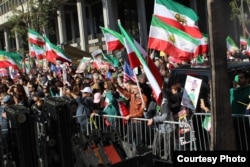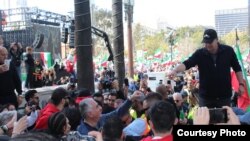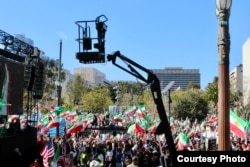A series of large rallies in Los Angeles in support of recent protests in Iran against Tehran’s Islamist leadership has revealed a surge of activism among young Iranian Americans who have no experience or memory of being in the Islamic republic.
A rally in early February was the biggest so far, drawing an estimated 80,000 to 100,000 people, according to a report by Los Angeles Magazine drawing upon Los Angeles police crowd-size estimates.
The February 11 gathering was timed to mark the 44th anniversary of Iran’s Islamic Revolution. The Shiite clerics who led that revolution are facing one of the most serious challenges to their authoritarian rule since a nationwide protest movement erupted in September.
Los Angeles Magazine reported that Iranian Americans previously held four large demonstrations in Los Angeles in solidarity with Iran’s protesters: three in October and one in November. It said those rallies drew 14,000 to 35,000 people.
The magazine article’s author, Iranian American journalist Karmel Melamed, was at the February 11 gathering and shared his observations, including the large presence of young demonstrators, in an interview for this week’s Flashpoint Iran podcast.
The following transcript of that interview has been edited for length and clarity.
VOA: What was the most interesting thing for you about that protest?
Karmel Melamed, Iranian American journalist: I think one the most interesting aspects of that protest was the sizable involvement of the Iranian American community from all over California. You had Iranians from Northern California: San Francisco, San Jose, Sacramento, from the Silicon Valley area; as well as Iranian Americans from Southern California, including San Diego, Orange County, Los Angeles. This was a really huge gathering of the community on the West Coast. The Iranian American community’s largest population is in California. So for them to come out in such huge numbers from all over the state was pretty amazing.
And another aspect that surprised me was the fact that the majority of these Iranian American protesters were not older people. They were younger people. And by younger, I mean teenagers, people in their 20s. They were not born in Iran. They have heard about Iran from their parents and their grandparents, and they have followed what is going on in their families’ former homeland. They felt a connection to their people, to the culture, to the country. And they came out and were voicing support for those protesters in Iran who are their own age.
VOA: How do you think they developed that connection?
Melamed: Absolutely the connection has come through social media. You have these young people, young Iranian Americans who are on social media — Instagram, Twitter, Telegram, Facebook — and they are interacting with young Iranians of their own age in Iran. And they're seeing these brave protesters, the majority of whom are, I would say, under age 25, and they have connected with them, age-wise. The passion of the protesters in Iran for freedom has resonated with these younger Iranian Americans, who found this common bond, this common cultural language with them, and decided to be their voice in America.
VOA: You have been one of the few journalists actually going out to the protests to try to find out what is going on. What have you learned from the people whom you have spoken to, about what they hope to achieve, and how these protests in Southern California are being seen inside Iran?
Melamed: Well, the protesters here in Southern California, from the Iranian American community, are trying to be the voices for their compatriots, for their friends, for their family members back in Iran. Those folks in Iran do not have a voice right now. The internet has been quashed or heavily suppressed in Iran. So they are not able to get out the messaging, the videos, the photographs of how protesters are being beaten, imprisoned, raped in Iran. So they have reached out to their friends and family in Southern California and the rest of the U.S. to be their voice, to share the atrocities.
VOA: So there is direct communication going on between those people inside Iran and in Southern California?
Melamed: Correct. The Southern California Iranian American community is just basically trying to get the news out to the rest of the free world and the rest of America, and to say, “Hey, don't sit quietly. There is a human rights catastrophe going on in Iran, and we need your help, we need the help of the U.S. government, the Western governments, to step in and pressure the Iranian government to stop killing, imprisoning, beating these protesters who are just demanding freedom and who are engaging in civil disobedience without any weaponry.” That has been the largest objective of the Iranian American community: to try to get the attention of the media and also elected officials.
The impact that this campaign has had on those protesters in Iran is massive. When those protesters have been able to get on to social media or the internet through various facets, and they have seen the protests from their brethren here in the U.S., whether in Southern California or elsewhere in America and even in Europe, they said: “Wow, this has given us encouragement. This has given us hope. We don't feel like we're alone. We feel like our compatriots, our family members, our friends who are Iranian like us — they haven’t left us alone, haven't forgotten us.”
That sense of camaraderie and unity has given those in Iran encouragement to continue their protests and continue the fight on their end, which is really courageous.










